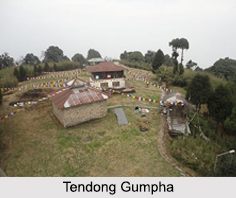 Tendong Gumpha, actually named as "Tendong Dichhen Salhun Gumpa" is situated atop the Tendong Hill. The gumpha is located at 8530 ft. altitude from mean sea level in Namchi, Sikkim. The monastery is surrounded by lush green virgin reserve forest. Tendong hill top has been the abode of spiritual gurus and other seeking seclusion for meditation. Because of its seclusion, there are no resident monks or nuns in this monastery.
Tendong Gumpha, actually named as "Tendong Dichhen Salhun Gumpa" is situated atop the Tendong Hill. The gumpha is located at 8530 ft. altitude from mean sea level in Namchi, Sikkim. The monastery is surrounded by lush green virgin reserve forest. Tendong hill top has been the abode of spiritual gurus and other seeking seclusion for meditation. Because of its seclusion, there are no resident monks or nuns in this monastery.
History of Tendong Gumpha
Tendong Gumpha was built in the year 1955 with the support of the then king Sir Tashi Namgyal and his queen Kunshang Dechen of Sikkim. Gomchen Pema Chewang Tamang was the main founder and head lama of Tendong Gumpha. He was also one of the 24 founder members of the Namgyal Institute of Tibetology, Gangtok.
Structure of Tendong Gumpha
There are two shrines, a two-story building comprising Gurulakhang (main monastery) and a small library which has recently been inaugurated. Second is Manilakhang where exclusively Cherenzig is worshipped and Mani prayer is done. One structure outside these monasteries serves the purpose of store and meditation hut. There is one two- room hut for the stay of visitors. There is a 50 ft. tall tower from where one can have 360 degree scenic view of mountain range and also offers a good view of majestic Kanchenjunga Peak.
In 2011 Sikkim earthquake, this monastery was also partially damaged and renovations were immediately done with the aid received from Sikkim Government.
Festivals at Tendong Gumpha
During March–April, on the 10th day of the Tibetan lunar calendar i.e. on "chesu", local people come to the monastery to pay their respect and gratitude to the head lama for offering prayers for their good health and good harvest.
Visiting Information of Tendong Gumpha
Nearest hamlet is Damthang which is 6 km from Tendong Gumpha and is well connected to rest of Sikkim. Several taxis and state buses run from Namchi, Gangtok and Ravangla to Damthang. From Damthang, Tendong Gumpha is accessible only by foot. The nearest airport is Bagdogra Airport (118 km) and nearest railway station is New Jalpaiguri Railway Station (113 km).



















